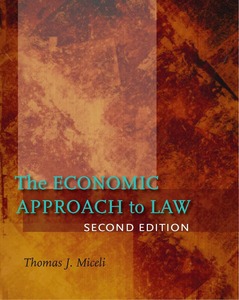Chapter 5
Non-compete clauses
Long term employment contracts often include non-compete clauses, which limit the ability of employees, when they leave the current firm, to enter into contracts with competing firms. For example, the employee may not be allowed to join a competing firm that is located within a certain geographic radius, or he may be forbidden to join a competing firm for a certain number of months or years. Such restrictions at first seem contrary to the principle of freedom of contract, or possibly represent violations of anti-trust laws. The legality of such restrictions, however, suggests that there may be an economic rationale.
Consider an untrained worker whose value to an employer is V0. Suppose the market has set the wage for these untrained workers at w0=V0. (Thus, the employer earns zero profit from untrained workers.) But now suppose that the employer can invest in the worker so that his value increases to V1. Let the cost of the investment be c, where
c < V1 • V0. (1)
Thus, the investment is efficient in the sense that it increases the worker’s value more than the cost. Suppose that after the investment, the employer offers the worker a raise to w1>w0. In order for the employer to receive a positive return from the investment, it must be true that
V1 • w1 • c • 0. (2)
Note that (2) implies that w1•V1•c since the employer has to cover the costs of the investment. This potentially creates a problem if competing firms also value the trained worker at V1 since they can offer a wage up to V1, which the original firm cannot match. If the worker leaves, the original firm is stuck with the cost of the investment but no return. And since it can foresee this, it will be reluctant to make the investment in the first place, thus resulting in an inefficient outcome.
In fact, we can use game theory to show that the equilibrium is for the original firm not to invest. The following table shows the two strategies for each player: “invest” or “not invest” for the firm, and “stay” or “leave” for the worker, along with the resulting payoffs. In each cell, the first entry is the firm’s payoff and the second is the worker’s.
Worker
Stay Leave
Invest V1•w1•c, w1 •c, V1
Firm
Not invest 0, V0 0, V0
Consider first the worker’s optimal strategy. If the firm invests, the worker will leave since he can get a higher wage from a competing firm (i.e., V1>w1). Alternatively, if the firm does not invest, the worker is indifferent between staying and leaving. Now consider the firm. If it expects the worker to stay it will invest (given (2)), but if it expects the worker to leave, it will not invest. The unique Nash equilibrium is therefore for the firm not to invest and for the worker to leave.
Now let’s see if a non-compete clause can yield the efficient outcome where the firm invests. Suppose that if a trained worker leaves, the firm can collect a monetary sanction of s dollars from the worker. This changes the payoffs in the upper right cell of the table to •c+s for the firm and V1•s for the worker. All other payoffs remain the same. Now suppose that we choose s so that it is desirable for the worker to stay when the firm invests. That is, w1>V1•s, or s>V1•w1. Combining this condition with (2) implies that s•c. That is, if a trained worker leaves, he must reimburse the original firm for at least his training cost. It should be clear that this results in a unique Nash equilibrium under which the firm invests and the worker stays.
